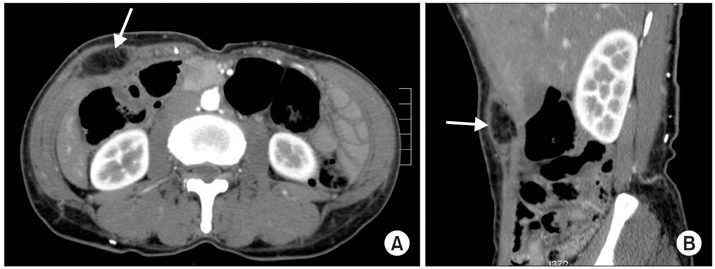J Gastric Cancer.
2012 Mar;12(1):46-48.
Diagnosis of a Trocar Site Mass as Omental Herniation after Laparoscopic Gastrectomy
- Affiliations
-
- 1Department of Surgery, Gyeongsang National University School of Medicine, Jinju, Korea. yileegnu@gmail.com
- 2Department of Pathology, Gyeongsang National University School of Medicine, Jinju, Korea.
- 3Department of Diagnostic Radiology, Gyeongsang National University School of Medicine, Jinju, Korea.
- 4Institue of Health Sciences, Gyeongsang National University School of Medicine, Jinju, Korea.
Abstract
- A trocar site hernia is a rare complication. We report a patient who had an abdominal wall mass at a previous trocar site after laparoscopic distal gastrectomy. It was diagnosed as omental herniation and fat necrosis. We conclude that patients with trocar site masses exhibiting fat density on a computed tomography scan could be followed up without surgery, and that fascial defects located at 10-mm or larger trocar sites should be closed whenever possible to prevent hernia formation.
Keyword
MeSH Terms
Figure
Reference
-
1. Ahmad SA, Schuricht AL, Azurin DJ, Arroyo LR, Paskin DL, Bar AH, et al. Complications of laparoscopic cholecystectomy: the experience of a university-affiliated teaching hospital. J Laparoendosc Adv Surg Tech A. 1997. 7:29–35.
Article2. Baird DR, Wilson JP, Mason EM, Duncan TD, Evans JS, Luke JP, et al. An early review of 800 laparoscopic cholecystectomies at a university-affiliated community teaching hospital. Am Surg. 1992. 58:206–210.3. Fear RE. Laparoscopy: a valuable aid in gynecologic diagnosis. Obstet Gynecol. 1968. 31:297–309.
Article4. Maio A, Ruchman RB. CT diagnosis of postlaparoscopic hernia. J Comput Assist Tomogr. 1991. 15:1054–1055.
Article5. Jeong SH, Lee YJ, Park ST, Choi SK, Hong SC, Jung EJ, et al. Risk of recurrence after laparoscopy-assisted radical gastrectomy for gastric cancer performed by a single surgeon. Surg Endosc. 2011. 25:872–878.
Article6. Hwang SI, Kim HO, Yoo CH, Shin JH, Son BH. Laparoscopic-assisted distal gastrectomy versus open distal gastrectomy for advanced gastric cancer. Surg Endosc. 2009. 23:1252–1258.
Article7. Lee YJ, Ha WS, Park ST, Choi SK, Hong SC. Port-site recurrence after laparoscopy-assisted gastrectomy: report of the first case. J Laparoendosc Adv Surg Tech A. 2007. 17:455–457.
Article8. Bergemann JL, Hibbert ML, Harkins G, Narvaez J, Asato A. Omental herniation through a 3-mm umbilical trocar site: unmasking a hidden umbilical hernia. J Laparoendosc Adv Surg Tech A. 2001. 11:171–173.
Article9. Bloom DA, Ehrlich RM. Omental evisceration through small laparoscopy port sites. J Endourol. 1993. 7:31–32.
Article10. Montz FJ, Holschneider CH, Munro MG. Incisional hernia following laparoscopy: a survey of the American Association of Gynecologic Laparoscopists. Obstet Gynecol. 1994. 84:881–884.
Article11. Helgstrand F, Rosenberg J, Bisgaard T. Trocar site hernia after laparoscopic surgery: a qualitative systematic review. Hernia. 2011. 15:113–121.
Article
- Full Text Links
- Actions
-
Cited
- CITED
-
- Close
- Share
- Similar articles
-
- A Case of Omental Herniation after Operative Laparoscopy
- Small Bowel Herniation Through a 5 mm Trocar Site: A Case Report
- Strangulated Small Bowel Herniation Through a 12-mm Trocar Site In an Obese Patient
- Two cases of small bowel herniation through 5 mm trocar site following removal of drains after gynecologic laparoscopy
- Small bowel herniation through trocar site after operative laparoscopy



